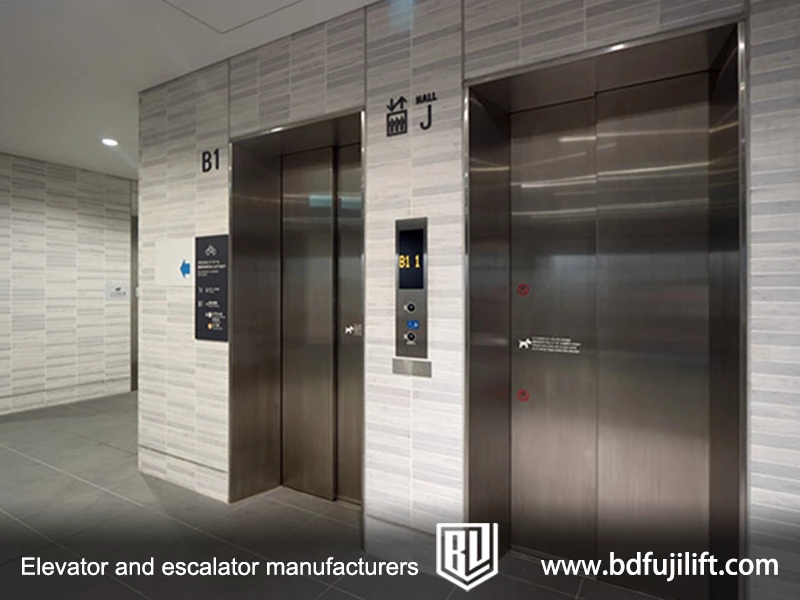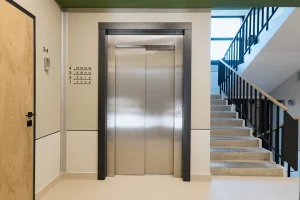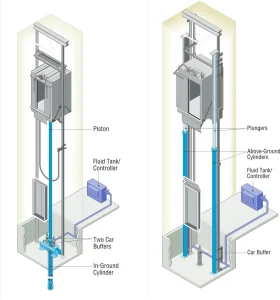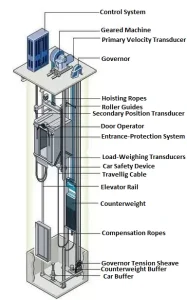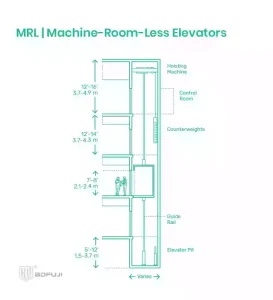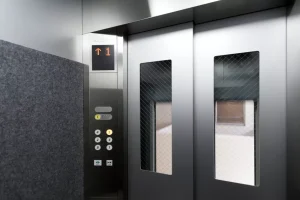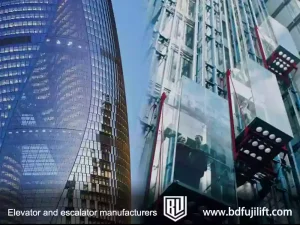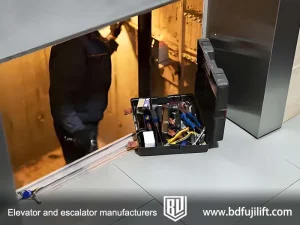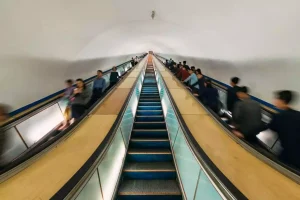Choosing an apartment elevator can be overwhelming due to the variety of brands and types. But, with the right approach, you can find the perfect elevator for your building.
Types of Apartment Elevators
Before choosing an apartment elevator, let’s explore the three most common types available on the market:
Hydraulic Elevators
A hydraulic elevator is powered by oil pressure to move the elevator up and down. By controlling the flow and pressure of the oil, the elevator can start and stop smoothly. Hydraulic elevators are cost-effective. Their machine room can be placed anywhere, saving space. This design eliminates the need for more space. But, due to system limitations, they are typically only suitable for buildings with up to 5 floors.
Traction Elevators
A traction elevator is driven by steel ropes and a traction wheel. The ropes suspend the car from the traction wheel, which moves the car up and down. Traction elevators are faster and can carry more weight. They are perfect for tall buildings with many people.
Machine-Room-Less Elevators(MRL Elevators)
Modern motors are compact and can be installed on the guide rails or walls, eliminating the need for a machine room. Newer designs use fiber-steel composite cables, reducing the need for lubrication and maintenance. Modern motors are smaller and can be installed on the guide rails or walls, removing the need for a machine room. These elevators are perfect for modern buildings with limited space.
Recommended Reading: What is an Apartment Elevator?
Key Factors to Consider When Choosing an Apartment Elevator
When choosing an apartment elevator, several important factors must be considered:
Load and Capacity
Choose the elevator’s load capacity based on the number of residents and floors in the building. Typically, Low-rise buildings can use elevators with smaller capacities. High-rise buildings need elevators with larger capacities and better performance.We can use the following formula to calculate the load and capacity required by the elevator:
Load Capacity (kg) = Number of floors × Number of residents per floor × 0.5 to 1.5 kg per person
(This value can vary based on local regulations and the building’s usage.)
Energy Efficiency
As energy costs rise, many apartment projects are choosing energy-efficient elevators. Choosing an efficient elevator can reduce energy consumption and lower long-term operating costs.
Safety and Comfort
The safety and comfort of the elevator directly affect the residents’ experience. Choose elevators with modern safety features, like emergency brakes and automatic door-closing systems. Also, consider noise control and comfort features to improve the riding experience.
Installation and Maintenance Costs
The installation and maintenance costs of different elevator types vary. Hydraulic elevators have lower installation and maintenance costs. Traction elevators are pricier but provide higher speed and capacity, making them perfect for high-rise buildings. When choosing an elevator, consider the building’s floors, budget, and maintenance needs.
Which Elevator is Best for Your Apartment Building?
The right elevator depends on the number of floors, resident needs, budget, and space limitations.
Low-Rise Apartments
For low-rise buildings, hydraulic elevators are typically the best choice. They run smoothly, are easy to maintain, and are suitable for small spaces.
High-Rise Apartments
For high-rise buildings, traction elevators are the optimal choice. They provide higher speed and greater load capacity, making them perfect for densely populated areas.
Space-Restricted Modern Buildings
If your building has limited space or needs a modern aesthetic, machine-room-less elevators might be the best choice. They save space and integrate well with contemporary designs.
Table 1: Characteristics of traction elevators, hydraulic elevators, and machine room-less elevators
| Elevator Type | Load Capacity | Suitable Floors | Speed | Applications | Advantages | Disadvantages |
|---|---|---|---|---|---|---|
| Hydraulic Elevator | Low to Medium | Up to 5 floors | Slow | Low-rise apartments, small buildings | Low installation and maintenance costs, smooth operation | Limited to low-rise buildings, slower speed |
| Traction Elevator | Medium to High | 6+ floors | Fast | High-rise apartments, commercial buildings | High speed, strong load capacity, energy-efficient | Higher installation and maintenance costs |
| Machine-Room-Less Elevator | Medium | 3+ floors | Medium | Modern buildings with space limitations | Space-saving, energy-efficient, modern design | Higher installation costs, complex system |
When Does an Apartment Need an Elevator?
According to the International Building Code (IBC), buildings taller than 3 stories or 13 meters must have an elevator.
Generally, a building around 13 meters high has about 3 to 4 floors. For buildings with 3 floors or fewer, installing an elevator is not required. So, apartment buildings with 3 floors or fewer usually don’t need elevators.
Conclusion
Choosing the right apartment elevator based on building height, budget, and space will maximize your property’s value. Contact BDFUJI now to explore more elevator options and receive a free quote and professional advice.
FAQ
Installation time depends on the elevator type, number of floors, building structure, and customization requirements. Traction elevators typically take 2 to 3 months to install, with more complex or high-rise installations taking longer. Hydraulic elevators are quicker to install, typically taking 1 to 2 months. Please note that these times do not include preparatory and approval processes.
How often does an apartment elevator need maintenance?
Apartment elevators need regular inspections. It is recommended to conduct a full maintenance check once a year to ensure safe operation.
What are the operating cost differences between different apartment elevator types?
Hydraulic elevators have lower operating costs, whereas traction and machine-room-less elevators typically have higher costs. However, they offer better efficiency and are better suited for high-rise buildings.


